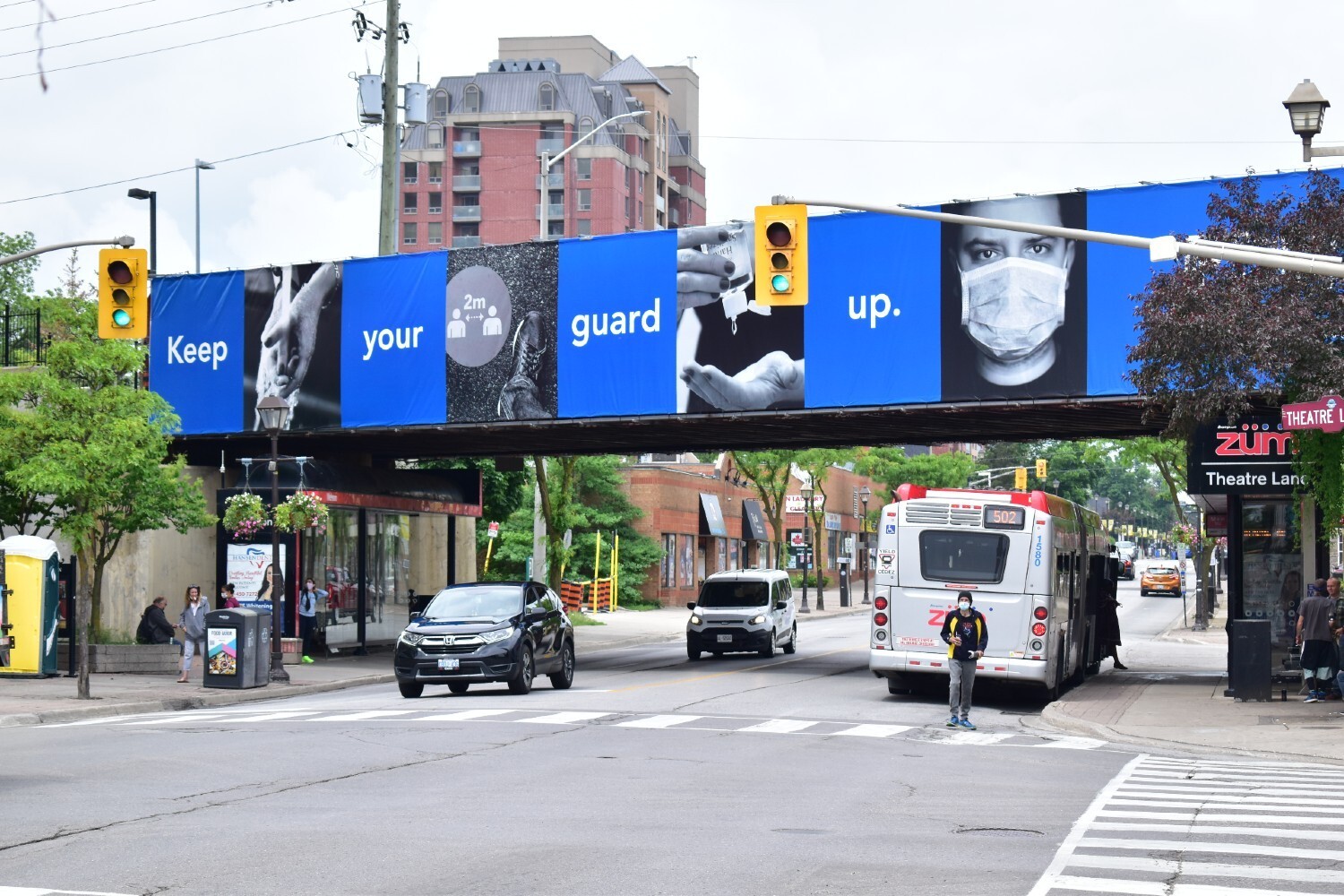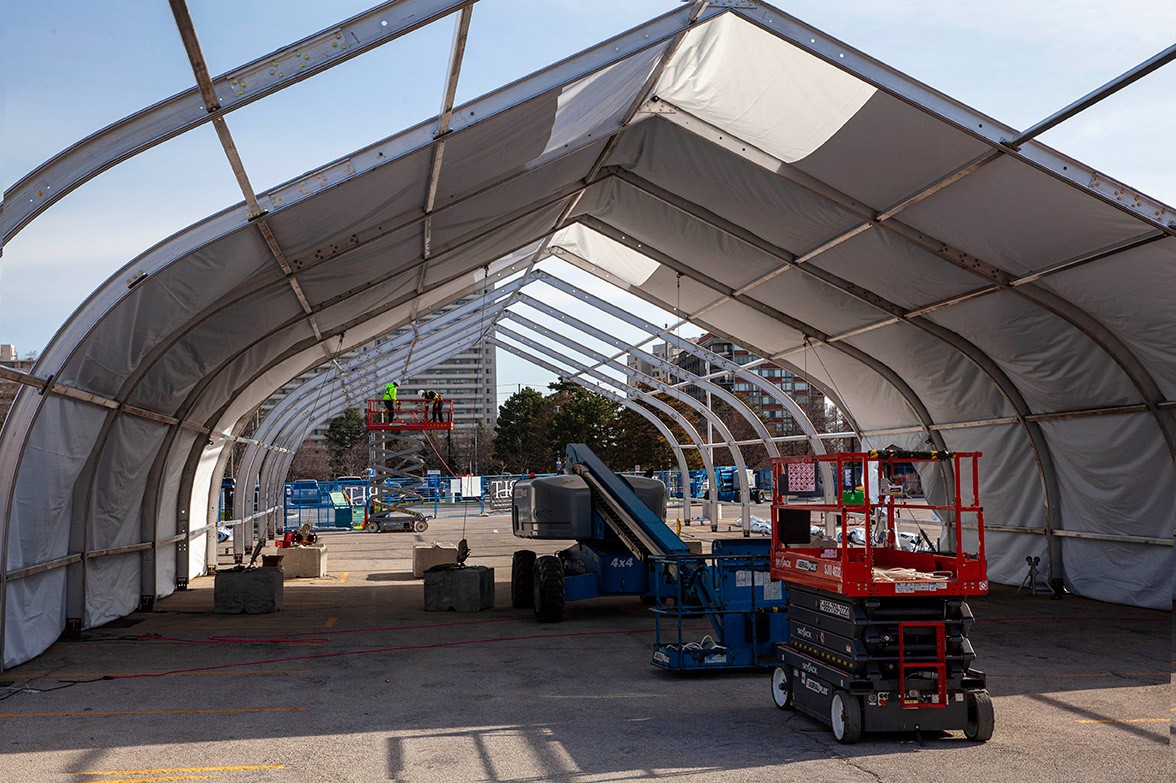
Peel’s pandemic indicators are all turning green; how does the Region move forward?
The construction of field hospitals and temporary testing sites as new case numbers soared across Ontario early in the pandemic was a sign of just how bad the COVID-19 crisis could get.
Now, with case numbers falling and a stable hospital picture, construction workers dismantling these temporary care and testing facilities is an omen of a better future.

A field hospital being constructed at Trillium Health Partners early in the pandemic.
(Image from Trillium Health Partners)
It is a sign Ontario’s vaccination campaign is paying off and we are finally winning the war against COVID-19. William Osler announced last week it would be winding down its vaccination clinics and testing centres over the next two months as its transitions back to pre-pandemic duties.
On July 11, the testing centre at Peel Memorial Centre for Integrated Health and Wellness closed down - Osler’s testing facility at Etobicoke General will be next to go on July 25. Vaccination clinics at Brampton Civic Hospital and Century Garden Recreation Centre will be among those that close in August.
“As COVID-19 admissions continue to decrease across our hospitals, community vaccination rates increase, and community partner testing centres and vaccination clinics remain readily available, Osler is focusing on recovery and gradual resumption of its operations,” Kiki Ferrari, Chief Operating Officer at William Osler, said in a recent media release. “We also continue to work with our partners to ensure both vaccine administration and testing services remain accessible and available to the communities we serve.”
William Osler is winding down its pandemic activities as case numbers continue to decline.
(Image from The Pointer files)
The pandemic indicators in Peel are showing sustained positive signals and leaders are urging cautious optimism. Daily case counts have tumbled from April highs above 1,000 new cases per day in the region to double and single digits. On July 13, Peel had a rolling seven day average of just 19 new COVID-19 cases per day; the average was 87 on June 13 and on May 13, it was 646.
The percentage of tests returning a positive COVID-19 result has also dropped dramatically. The rate of new positive tests can give public health officials an indicator of how successful their testing regime is: if rates are low then policy makers can be confident they have a good grip on the pandemic.
At the height of the third wave, Brampton’s positivity rate exceeded 20 percent. A few short months later, on June 27, Brampton’s rate sat at 1.9 percent, Caledon’s was 1.2 percent and Mississauga’s was 1.1. Health Minister Christine Elliott has previously cited 2.5 percent positivity as the threshold she wants to see public health units below.
“We cannot become complacent,” Dr. Lawrence Loh, Peel Public Health’s medical officer of health, said at Mississauga’s Wednesday press conference. “The good weather coupled with our increased vaccination coverage has allowed us to take advantage of lower risk activities and start to gather in smaller groups, but we cannot get distracted. Please, get to two valid vaccine doses as quickly as possible.”
As of July 12, 78.3 percent of eligible Peel residents have received at least one COVID-19 vaccination. More than half (52 percent) of residents have had two doses.
While the vaccination program continues to pose some challenges and each new stage of reopening comes with risks, minds are also turning to the future. The dismantled testing infrastructure at William Osler and other hospitals around Ontario will be replaced with an Ontario-wide system to keep a finger on the waning pandemic’s pulse and ensure things don’t get out of control.
For more than a month, Ontario’s daily testing rate has sat at or below 30,000 tests per day. In early January, it reached its peak at just over 76,000 tests in a single day.
The low rate of positive tests suggests lower testing is not an immediate problem, instead the lower demand on testing infrastructure allows for a moment of reflection to move forward.
How will Ontario stay safe in a world where the threat of variants, especially from places with lower vaccination rates than Canada, will continue to persist?
“Like anything in this pandemic it seems as if there’s flip flopping, but it’s not actually flip flopping at all. It’s just either gaining through experience or the situation really dramatically changes,” Barry Pakes, assistant professor with the Department of Public Health Sciences, Dalla Lana School of Public Health at the University of Toronto, told The Pointer. “The question of COVID testing infrastructure and our strategies entirely depends on our dynamics.”
Pakes argues general asymptomatic testing when cases are low is an unhelpful tactic. Making asymptomatic testing available to anyone who wants it can allow the most concerned (and least at risk) residents to get tested, it can cause lab backlogs, return false positives and even create a false sense of security. The need to monitor for new variants will remain, but is best tackled through a plan to systematically test random individuals, not voluntary clinics.
Caitlin Clark, spokesperson for the Minister of Education, told The Pointer free testing would continue “all year” for students, families and education workers. The program will remain in place beyond September.
The Ministry of Health did not respond to questions in time for publication.
“We have testing strategies in our society for many, many infectious and noninfectious diseases and conditions, and surveillance is critical for knowing what’s going on and planning to prevent it,” Pakes said.
A surveillance strategy for new variants in a largely vaccinated society is a long-term consideration. As Loh has been keen to stress, Peel is not guaranteed an irreversible route to the post-pandemic world, yet. Countries like the UK and Israel have seen viral resurgences after they pushed towards a rapid reopening and Ontario’s chief medical officer of health, Dr. Kieran Moore said Tuesday, he “absolutely” expects COVID-19 activity to increase this fall.
Home-based lateral flow kits are being offered to all residents in England to monitor for local outbreaks. The kits are mailed out and return results at home, a process the National Health Service (NHS) compares to pregnancy tests. The system has the benefit of simplicity, but it is not the panacea and home tests are not sequenced at labs to detect emerging variants of concern.
“You should do a rapid test twice a week (every 3 to 4 days) to check if you have the virus. If people test positive and self-isolate, it helps stop the virus spreading,” the NHS website states.
In Ontario, COVID-19 is far from the only viral threat and random testing is already taking place for illnesses, including respiratory syncytial virus (RSV). Urgent care centres and family doctors, for example, complete testing for influenza in some patients who present with upper respiratory symptoms. When vaccination rates increase and cases fall further, it is likely regular COVID-19 will join the ranks of Ontario’s testing strategies.
Loh says he supports a surveillance regime for COVID-19 testing in Ontario, one he expects to remain the responsibility of Queen’s Park. Under his watch, Peel Public Health is gearing up to play a long-term, frontline role in the fight against COVID-19.
“I think COVID overall will continue to be a significant part of our work as a local public health unit going forward,” Loh said. “It will represent likely new programs both to continue with case management and contact tracing, outbreak investigation, vaccine coverage rates and tracking, certainly reaching the most vulnerable through vaccination. These are all discussions that are currently taking place across local public health units in Ontario.”
Email: [email protected]
Twitter: @isaaccallan
Tel: 647 561-4879
COVID-19 is impacting all Canadians. At a time when vital public information is needed by everyone, The Pointer has taken down our paywall on all stories relating to the pandemic and those of public interest to ensure every resident of Brampton and Mississauga has access to the facts. For those who are able, we encourage you to consider a subscription. This will help us report on important public interest issues the community needs to know about now more than ever. You can register for a 30-day free trial HERE. Thereafter, The Pointer will charge $10 a month and you can cancel any time right on the website. Thank you.
Submit a correction about this story


